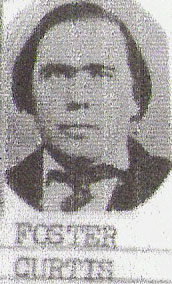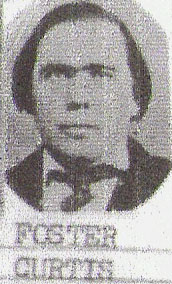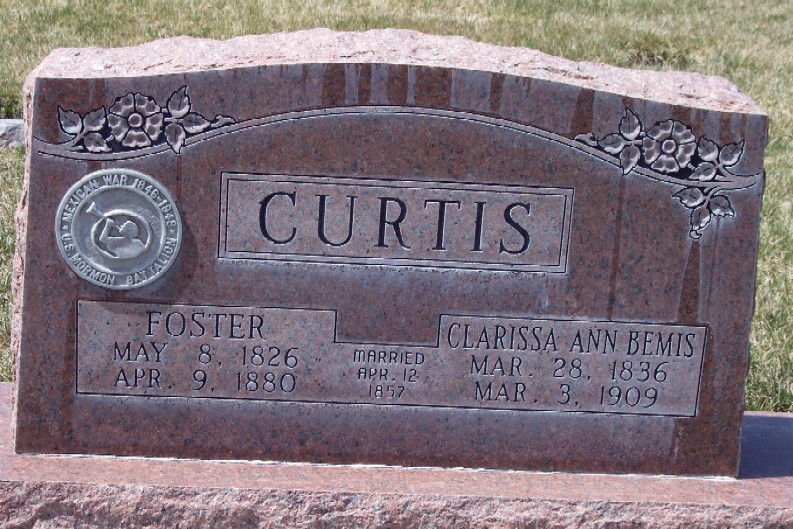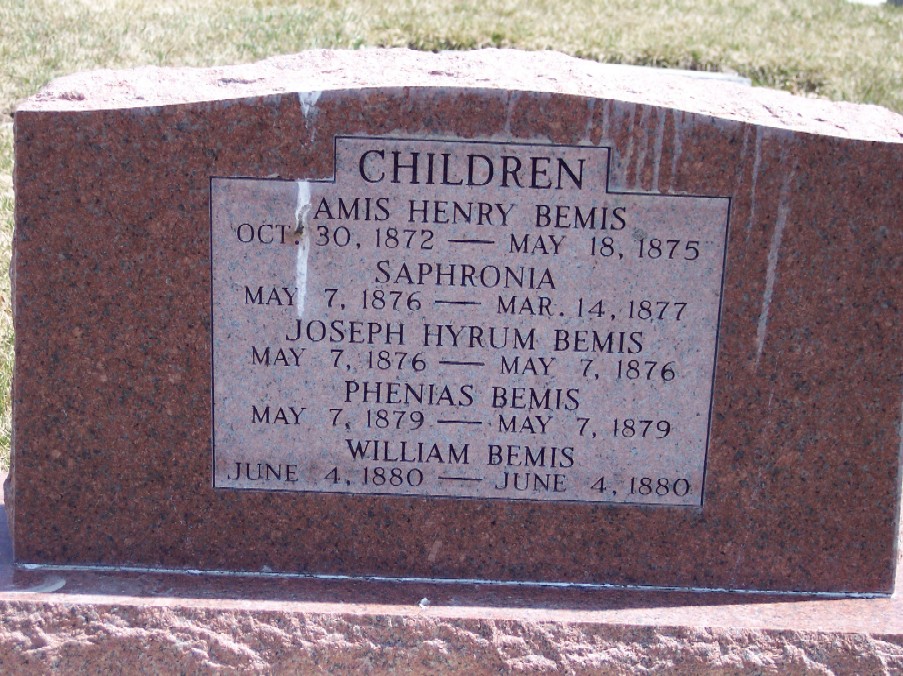Married Clarissa Ann Bemis, 12 Apr 1857, San Bernardino, California
Curtis, Foster – born 8 May 1826 in Michigan to parents born in Massachusetts, who moved to Pennsylvania and then to Michigan by 1823. They joined the LDS Church and relocated to Missouri. At the age of eleven Foster was baptized in the LDS Church in September of 1837 in Caldwell County, Missouri. His mother died a year later at the same location. The family was forced out of Missouri and came to live in Nauvoo where the father died in March of 1846. Some of the Curtis family were in the exodus from Illinois and crossed Iowa to the Council Bluff area. Here twenty-year-old Foster was mustered in as a Pvt. in Co. D of the Mormon Battalion on 16 July 1846. He marched with the battalion to Ft. Leavenworth, Kansas where the battalion received their military equipment. The battalion followed the Santa Fe Trail to the crossing of the Arkansas River, where they took the Cimarron Cutoff to Santa Fe, New Mexico. They marched down the Rio Grande to where General Stephen W. Kearny's force abandoned their wagons and used pack animals to travel to California. Lt. Colonel Phillip St. George Cooke of the U.S. Army led the Mormon Battalion in blazing Cooke's Wagon Road to the Pacific. They traveled a short distance further down the river and then struck southwest and went through the Guadalupe Mountains and on to Tucson, the Pima Villages on the Gila River to the Colorado River. Crossing the river into California, they went on to Warner's Ranch, San Luis Rey Mission and then to San Diego, arriving on January 29, 1847. They performed garrison duty and construct a fort at Los Angeles. Curtis and his comrades were mustered out of service on 16 July 1847. Levi Hancock organized the discharged soldiers into groups as the Mormons had in their exodus from Nauvoo into groups of hundreds, fifties and tens. Curtis was one of the captains of tens in Capt. Jefferson Hunt's fifty and they left San Pedro July 22nd and traveled north along the coast to San Francisco and then to Sutter's Fort. Capt. Hunt and a small "picked" party left Sutter's on August 26thand headed for the Truckee route over the mountains with the remaining four tens that included Curtis' ten, leaving the following day with Hunt's entire group leaving in advance of the other companies under Hancock. They traveled 18 miles north and turned eastward and went over the crest of the Sierra Nevada Mountains and moved downward towards Truckee Lake when they encountered Samuel Brannan, returning to California. He was very disgruntled that he had been unable to persuade the Mormons to continue on to California. The following day they met Capt. James Brown, coming from Salt Lake and they gathered the various Mormon parties together to receive the Church's counsel for the ex-soldiers. They were told that supplies were very short in the Salt Lake Valley and that those men without adequate provisions should remain in California to work until the following year. Upon hearing this, about half of the assembled company returned to California to find employment. Foster Curtis returned to Sutter's Fort where he was listed as one of Sutter's workmen. We don't know which party he joined to travel to Utah but apparently arrived there in 1848. He lived and worked in Salt Lake City until about 1855 when he moved to the Mormon colony at San Bernardino in southern California. Here he met and married Clarissa Ann Bemis in April of 1857. The couple's stay in San Bernardino was cut short when the Church ordered it abandoned due to the Utah War. They returned to Utah, living in the Salt Lake area until about 1871 when they moved to Cache County, settling at Newton. Foster died at Newton on 9 April 1880 and was buried in the Newton Cemetery. He was included on Daniel Tyler's "Surviving Members of the Battalion" list published in 1881 and listed as a "farmer" in Newton. In reality he had died about a year previous to Tyler's book being published.
* Mormon Battalion members
Married Clarissa Ann Bemis, 12 Apr 1857, San Bernardino, California
Curtis, Foster – born 8 May 1826 in Michigan to parents born in Massachusetts, who moved to Pennsylvania and then to Michigan by 1823. They joined the LDS Church and relocated to Missouri. At the age of eleven Foster was baptized in the LDS Church in September of 1837 in Caldwell County, Missouri. His mother died a year later at the same location. The family was forced out of Missouri and came to live in Nauvoo where the father died in March of 1846. Some of the Curtis family were in the exodus from Illinois and crossed Iowa to the Council Bluff area. Here twenty-year-old Foster was mustered in as a Pvt. in Co. D of the Mormon Battalion on 16 July 1846. He marched with the battalion to Ft. Leavenworth, Kansas where the battalion received their military equipment. The battalion followed the Santa Fe Trail to the crossing of the Arkansas River, where they took the Cimarron Cutoff to Santa Fe, New Mexico. They marched down the Rio Grande to where General Stephen W. Kearny's force abandoned their wagons and used pack animals to travel to California. Lt. Colonel Phillip St. George Cooke of the U.S. Army led the Mormon Battalion in blazing Cooke's Wagon Road to the Pacific. They traveled a short distance further down the river and then struck southwest and went through the Guadalupe Mountains and on to Tucson, the Pima Villages on the Gila River to the Colorado River. Crossing the river into California, they went on to Warner's Ranch, San Luis Rey Mission and then to San Diego, arriving on January 29, 1847. They performed garrison duty and construct a fort at Los Angeles. Curtis and his comrades were mustered out of service on 16 July 1847. Levi Hancock organized the discharged soldiers into groups as the Mormons had in their exodus from Nauvoo into groups of hundreds, fifties and tens. Curtis was one of the captains of tens in Capt. Jefferson Hunt's fifty and they left San Pedro July 22nd and traveled north along the coast to San Francisco and then to Sutter's Fort. Capt. Hunt and a small "picked" party left Sutter's on August 26thand headed for the Truckee route over the mountains with the remaining four tens that included Curtis' ten, leaving the following day with Hunt's entire group leaving in advance of the other companies under Hancock. They traveled 18 miles north and turned eastward and went over the crest of the Sierra Nevada Mountains and moved downward towards Truckee Lake when they encountered Samuel Brannan, returning to California. He was very disgruntled that he had been unable to persuade the Mormons to continue on to California. The following day they met Capt. James Brown, coming from Salt Lake and they gathered the various Mormon parties together to receive the Church's counsel for the ex-soldiers. They were told that supplies were very short in the Salt Lake Valley and that those men without adequate provisions should remain in California to work until the following year. Upon hearing this, about half of the assembled company returned to California to find employment. Foster Curtis returned to Sutter's Fort where he was listed as one of Sutter's workmen. We don't know which party he joined to travel to Utah but apparently arrived there in 1848. He lived and worked in Salt Lake City until about 1855 when he moved to the Mormon colony at San Bernardino in southern California. Here he met and married Clarissa Ann Bemis in April of 1857. The couple's stay in San Bernardino was cut short when the Church ordered it abandoned due to the Utah War. They returned to Utah, living in the Salt Lake area until about 1871 when they moved to Cache County, settling at Newton. Foster died at Newton on 9 April 1880 and was buried in the Newton Cemetery. He was included on Daniel Tyler's "Surviving Members of the Battalion" list published in 1881 and listed as a "farmer" in Newton. In reality he had died about a year previous to Tyler's book being published.
* Mormon Battalion members
Family Members
-
![]()
Clarissa J. Curtis
1858–1859
-
![]()
Esthmia Perthenia Curtis
1859–1864
-
![]()
Nahum Curtis
1863–1942
-
![]()
Foster Alvin Bemis Curtis
1865–1866
-
![]()
Owen Bemis Curtis
1866–1940
-
![]()
Eli Nephi Bemis Curtis
1870–1938
-
![]()
Amis Henry Bemis Curtis
1872–1875
-
![]()
Joseph Hyrum Bemis Curtis
1876–1876
-
![]()
Saphronia Curtis
1876–1877
-
![]()
Phenias Bemis Curtis
1879–1879
-
![]()
William Bemis Curtis
1880–1880
Advertisement
Records on Ancestry
Sponsored by Ancestry
Advertisement
























